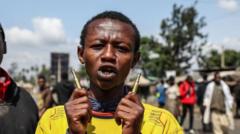In Africa, the rising threat of venomous snake bites is exacerbated by poverty, deforestation, and climate change, leading to tragic consequences for vulnerable populations.**
The Silent Crisis: Combating Snakebites in Rural Africa**

The Silent Crisis: Combating Snakebites in Rural Africa**
Millions suffer every year from snakebites, with rural communities facing the greatest risk and lack of medical access.**
In the rural landscapes of Africa, a silent crisis unfolds as venomous snakes slip into homes and fields, causing severe health consequences for the most vulnerable. An estimated five million people are bitten each year, resulting in a staggering 120,000 fatalities and around 400,000 amputations. For many, including low-income residents in nations such as Kenya, access to timely medical care is an ongoing challenge.
One poignant story emerges from Kenya involving 11-year-old Beatrice Ndanu Munyoki, who fell victim to a snake strike while tending to her family's goats. The quick actions of her father, David Mutunga, rushed her through inhospitable terrain to seek medical assistance, but the local hospital lacked the necessary antivenom. After multiple delays, Beatrice eventually received treatment, but not without cost—her finger ultimately needed amputation.
Such incidents highlight the often dire consequences of snake bites, with rural areas facing significant barriers to healthcare, heavily influenced by shifting land use due to climate change, deforestation, and expanding human settlements. Communities are not only at risk from the snakes themselves but also from the environmental factors that bring snakes and people into closer proximity.
As the climate continues to change, and human development encroaches on natural habitats, it is vital to expand awareness of this public health issue and improve access to snakebite treatments. Local initiatives must focus on educating communities about prevention, providing better healthcare resources, and addressing the larger environmental challenges that intensify the snake-human conflict. In doing so, we can begin to turn the tide on this growing public health emergency, ensuring rural populations are no longer left to battle these dangers alone.




















